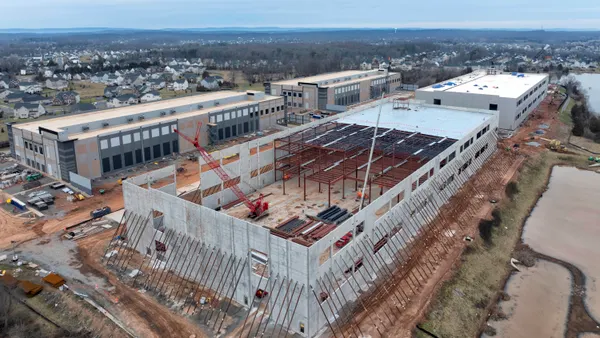Dive Brief:
- Standing less than 3 feet tall and equipped with 3D vision and 17 joints, Boston Dynamics' SpotMini robot dog is a good fit for construction sites because of its range of motion, 3D vision and ability to navigate obstacles, company officials claim. The engineering and robotics design firm is on pace to produce 1,000 SpotMini robots per year by the end of 2019, reported Inverse.
- In a video released this month, SpotMini walks around a Takenaka Corp. construction site in Tokyo in which it navigates stairs; avoids obstacles such as window holes raised off the floor, steel beams and orange cones; and intermittently pauses to scan the area. Another recent video from Boston Dynamics further shows the SpotMini’s flexibility and agility by having it perform dance moves like the moonwalk.
- The all-electric robot, which the firm claims can operate for 90 minutes on one charge, can survey a project via its onboard camera and pick up and handle objects with perception sensors and an arm with five degrees of freedom.
Dive Insight:
Robots are well on their way to becoming valuable members of construction teams. SpotMini is just one of Boston Dynamics' several robots. The much-anticipated Atlas humanoid robot isn’t as close to market as SpotMini is — it’s not even clear yet if the company will sell Atlas — but the humanoid robot can achieve whole-body mobile manipulation through coordinating arm, torso and leg motions. It also boasts exceptional balancing ability while performing tasks, which the company says will allow it to “work in a large volume while occupying only a small footprint.”
Japan’s Advanced Industrial Science and Technology Institute also recently unveiled a humanoid bot, the HRP-5P, that, by combining environmental detection, object recognition and careful movement planning, can install drywall independently. Although not nearly as flexible as a human, it compensates by having numerous joints that can flex to degrees people aren’t able to, as well as correcting for slips and having a field of view beyond that of a human’s. The research team hopes to collaborate with private companies that will treat the bot as a development platform and lead to further breakthroughs, eventually tackling the “manual shortages” Japan is facing.
Technology appears to be one of the top methods construction companies are using to alleviate the labor shortage. Some industry respondents to a survey from the Associated General Contractors of America and Autodesk this fall indicated they are introducing virtual construction, offsite prefabrication, BIM, drones, GPS, laser-guided equipment and 3D printing to help ease labor shortages.












